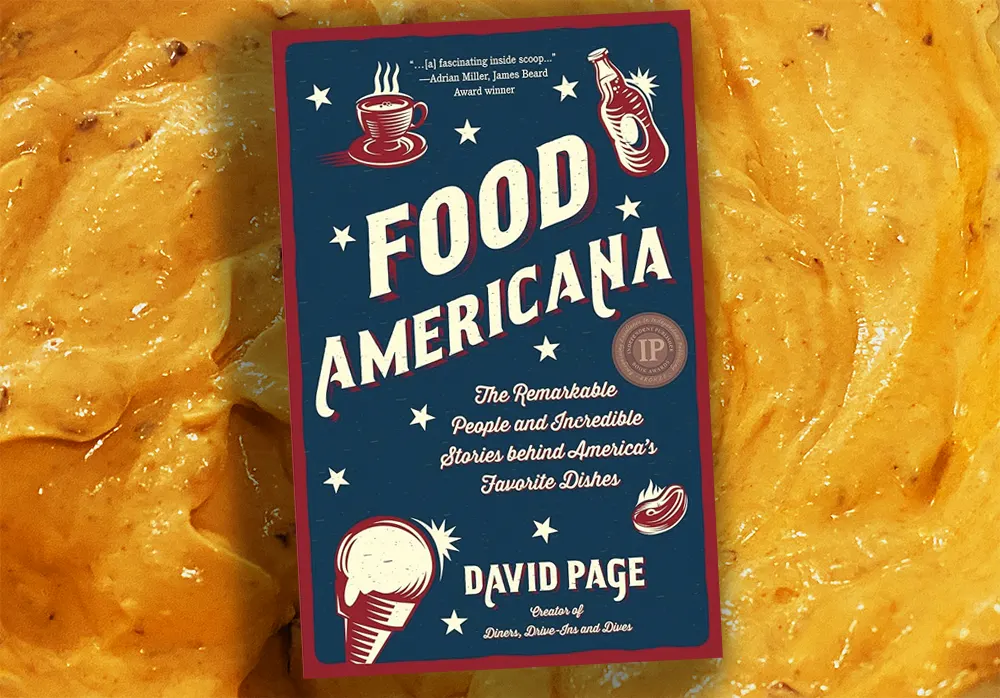A Look at America’s Melting Pot in David Page’s Food Americana
By Ian MacAllen on Friday, May 17th, 2024 at 4:31 pm

The melting pot of America is never more evident than in the country’s cuisine. The food we eat tells us a lot about who we are and where we came from. In Food Americana: The Remarkable People and Incredible Stories behind America’s Favorite Dishes, David Page takes us through the journey of how many different foods become part of a larger American cuisine, examining the multinational origins and the evolution in restaurants across the country.
David Page has a background in television. He created and produced the Guy Fieri-hosted Diners, Drive-Ins and Dives, among other programs, lending credibility to his food research. However, his background in television comes across in the episodic structure of the book. Each chapter focuses on a particular style of cooking like barbecue, sushi, and chicken wings, and it feels like he’s plotting a season of docu-drama style television.
Page has done a decent job of distilling American cuisine into broad categories, although there are a few chapters where it’s evident a single food lacked enough content to build a whole chapter. Lobster rolls are combined with oysters, and mozzarella sticks are tacked onto wings. It’s not that these dishes don’t make sense together, but they also aren’t really connected in anyway.
Page excels at storytelling. Food origins are rarely perfect, and he’s pieced together solid narratives that are entertaining to read. He integrates interviews with people involved in food production and selling, and peppers the text with factoids. Some of these tidbits are the sort of things shared at cocktail parties. For instance, Rocky Road ice cream, he asserts, was created in the aftermath of the 1929 stock market crash, as a kind of signal to the uncertain future. There are perhaps more of these asides than hard hitting research into who it was who created it.
The book’s ambition is large and the topic expansive. American cuisine is huge and represents the many different cultures, ethnicities, and immigrant groups who have arrived in the United States. However, Food Americana is more of a survey of these foods rather than an in-depth history lesson. There are better books for every subject here, like the chapter on Chinese American food that briefly looks at the introduction of the cuisine into the United States. Page does a decent job of mentioning other relevant books like Andrew Coe’s Chop Suey: A Cultural History of Chinese Food in the United States (a book I would also recommend), but speeds through so much of the history. He’s more concerned with the bigger picture.
The book begins with pizza, a subject I am quite familiar with, having written Red Sauce: How Italian Food Became American. Page chooses to focus on a combination of chain pizzerias like Domino’s and Pizza Hut, and celebrity chefs, and both are important vectors on how pizza became integral to American cuisine. But it’s also a superficial look. Ira Nevin, inventor of the gas-fire pizza oven is never mentioned, and his creation is perhaps as important as anything cooked up in the kitchen of a chain pizzeria. The book does run through some of the regional styles of pizza, but never connects them as part of a broader narrative. He also left quite a few behind on the edit room floor. I can recognize perhaps in this chapter I’m more of an expert than most readers, but it still left me a bit disappointed.
Ultimately this is the problem I have with this book. Every chapter has a better or at least a more indepth book written about the type of food. That’s not to say Food Americana isn’t interesting, and Page does tell compelling stories, but they do feel light on details. In chapters on food subjects where I’m less well read like sushi and ice cream, there was plenty to like, in part because I didn’t know what I didn’t know. But this is also where Page as a storyteller shines. While he may not present every detail of the rise and fall of sushi in America, he’s curated the more interesting components of it. That’s especially true in discussing sushi. Sure, he looks at high end restaurants, but also gas station sushi too. When we talk about authenticity, acknowledging that for many people, the food from strip malls, convenience stores, and gas stations actually is the most authentic is hard to do in a world focused on celebrity.
Perhaps though the biggest shortcoming of the book is the lack of a singular theme connecting the book together. Every chapter is compartmentalized with little if any overlap. For instance, even though the chapter on Mexican American food follows the one on pizza, there’s no mention of Ike Sewell. Sewell was behind Pizzeria Uno and the creation of Chicago’s iconic deep dish pizza – but he originally wanted to open a Mexican restaurant (To think we could have had deep dish tacos). Like a television show, each of these chapters exists in a void by itself.
If there is any kind of overarching theme–and it’s tough to find one because each chapter is written to stand alone – then it is in the way these foods enter into American culture. The emphasis is on the transition from ethnic food to American food, and how these dishes became consumed nationally rather than regionally.
As a survey of American cuisine, Page has been successful at summarizing the foods we eat, and to a lesser extent how we came to eat them. Often though, I was left hungry for more. To his credit, Page usually drops a few titles worth reading on the subject. I found myself highlighting these most often. Food Americana is a fun, light read. It’s the perfect treat to read on the beach before heading over for lobster roll (penultimate chapter) and ice cream (last chapter).
***

